A memorial address by Tore Frängsmyr *
The Royal Swedish Academy of Sciences
26 March 1996
Probably no Swede is as well-known throughout the world as Alfred Nobel – not our medieval saints, nor even our contemporary sports heroes. At the same time, we must admit that his renown is more indirect than direct. This means that while the Nobel Prize is extremely well-known all over the world, the person behind it remains relatively unknown.
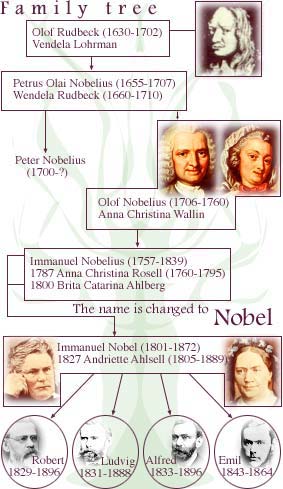
Family tree.
Admittedly, quite a lot has been written about Alfred Nobel, but a large part of this literature consists of clichés. It is often a question of sentimental depictions of a lonely millionaire who – despite his wealth – was unhappy or at least deeply melancholic, emotionally attached to his mother, and with a few heart-rending love stories behind him. This is not altogether a false picture. Alfred Nobel was lonely and he was clearly unlucky in love, but such accounts are not so instructive. Romantic tales constitute a special genre, to which I shall not attempt to contribute. Instead, I will focus on the scientific and technical fields.
First, however, I would like to recount some important facts about Alfred Nobel’s life. He was born in Stockholm in 1833 into a family of engineers. His family was descended from none other than Olof Rudbeck, the best-known technical genius of Sweden’s 17th century era as a Great Power in Northern Europe.
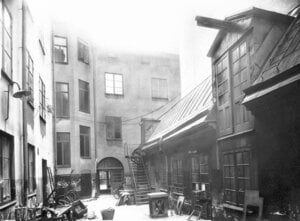
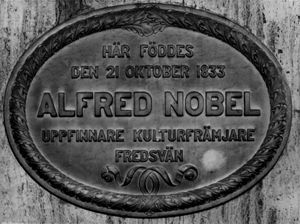
This plate decorates the present building at Norrlandsgatan 9. It says: “Alfred Nobel, the inventor, culture promoter, pacifist was born here on October 21, 1833.”
Having gone through a recent bankruptcy, when Alfred was five years old his father Immanuel Nobel moved to St. Petersburg, where he started a mechanical workshop for the manufacture of land mines. In 1842, when Alfred was nine years old, the rest of the family also moved to St. Petersburg.
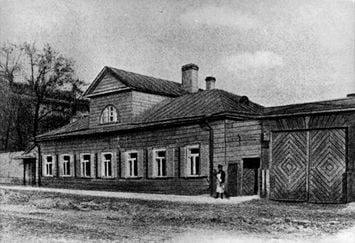
The home of the Nobel family in St. Petersburg, Russia in the 1840s.
By then his father’s fortunes had improved, enabling the family to live in high bourgeois style. At the time, St. Petersburg was a world metropolis, alive with scientific, social, and cultural life. Immanuel Nobel’s sons did not attend school, but were instead educated at home by outstanding teachers at the level of university professor. The instruction they provided focused on both the humanities and the natural sciences. Aside from Swedish, Alfred and his brothers were taught Russian, French, English and German, as well as literature and philosophy. In the natural sciences, they were guided by two professors of chemistry who taught them mathematics, physics and chemistry. Considering the specialty of his teachers, it was perhaps no coincidence that Alfred took a liking to chemistry. He learned to conduct chemical experiments, an activity that seemed to fascinate him from the very beginning. Alfred spent his most important formative years in the Russian capital. With his five languages, which he seemed to have mastered well, he laid the foundation for the cosmopolitan nature that would later become so prominent in his life.
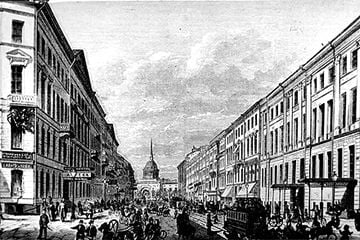
Nevskij Prospekt, the main street of St. Petersburg, in the 1870s.
During the years 1850-52, Alfred was allowed a few study-oriented stays abroad. He spent one year in Paris with the famous chemist Jules Pelouze, a professor at the Collège de France who had just opened a private training laboratory. Pelouze, who incidentally had been a good friend of the Swedish chemist Berzelius, had also taught Nikolai Zinin, one of Alfred Nobel’s private teachers. During that year, Alfred completed his training as a chemist. But somewhere around the same time was the inception of what would become the greatest inventions of his life. For it was then, if not earlier, that he must have heard about the remarkable explosive called nitroglycerine. Strangely enough, this has not been pointed out by many scholars, who have dated the crucial moment 10 years later.
Here is the background. In 1847, in Turin, Ascanio Sobrero – an Italian student of Pelouze – had discovered a new explosive that he initially called pyroglycerine (later known as nitroglycerine). However, Sobrero, both in letters to Pelouze and in a subsequent journal article, issued a warning about the new compound, not only because it had incredible explosive power, but also because it was impossible to handle. Sobrero’s discovery did not come as a bolt from the blue. As early as the 1830s, Pelouze himself and others had conducted important preliminary work by making guncotton. Since Alfred was extremely interested in explosives – it was of course a family interest – and since Pelouze had both first-hand knowledge of how explosives were manufactured and was familiar with Sobrero’s discovery, Alfred must have learned about nitroglycerine at that time. However, any excitement he might have felt was immediately dampened by the difficulties of both manufacturing and handling the new compound.
The end of the Crimean War (1856) spelled disaster for Immanuel Nobel’s factory, which had lived off the manufacture of war materiel. The factory went bankrupt, and Alfred’s parents and their youngest son Emil moved back to Sweden. The three older sons stayed in St. Petersburg to put the family affairs in order and restructure the company. Faced with this situation, Alfred and his brothers discussed various conceivable projects with their former teachers. That was when Nikolai Zinin reminded them of the potential of nitroglycerine. Professor Zinin is said to have demonstrated the power of nitroglycerine by pouring a few drops of the fluid on an anvil, striking it with a hammer, and producing a loud bang. But only the liquid that came into contact with the hammer exploded. The rest of the liquid was not affected. The problem, as Sobrero had already realized, was two-fold. First, it was difficult to manufacture the compound, because at excessive temperatures the whole batch exploded. Second, once manufactured, the liquid was equally difficult to explode in a controlled fashion.
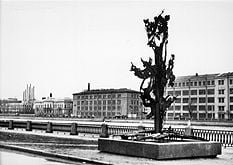
Nobel monument “Blown up Tree” on the bank of the River Neva, St. Petersburg.
During the years around 1860, Alfred conducted repeated experiments involving great risks. First, he succeeded in manufacturing sufficient quantities of nitroglycerine without any mishaps. Then, he mixed nitroglycerine with black gunpowder and ignited the mixture with an ordinary fuse. After several successful explosions outside St. Petersburg on the frozen Neva River, Alfred traveled back to Stockholm. There, his father had begun similar experiments (though with less success) after reading about Alfred’s tests in his letters. Immanuel Nobel even insisted that the new mixture was his own idea, but he backed off from this assertion after a sharp letter from Alfred that set matters straight in no uncertain terms. Instead, he even helped Alfred apply for a patent in his own name. In October 1863, Alfred Nobel was granted a patent for the explosive that he aptly called “blasting oil.”
With his first patent, Alfred had also reached his first milestone. Although he was only 30 years old, this was the start of an exciting adventure that would unfold with great speed. During the following spring and summer, Alfred continued his experiments. He soon obtained a new patent related to the manufacture of nitroglycerine (using a simplified method) as well as the use of a detonator, or what was called an “initial igniter,” in other words a hollow wooden plug filled with black gunpowder (later called a “blasting cap”). The determination and self-confidence that would later become more pronounced features of Alfred’s personality were already apparent. He wrote: “I am the first to have brought these subjects from the area of science to that of industry,” and he successfully arranged a large loan from a French bank.
* * *
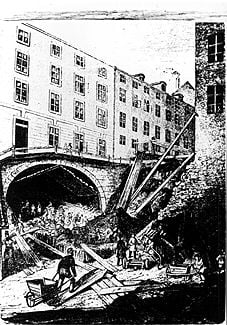
The Söder tunnel in Stockholm was built with help of Alfred Nobel’s blasting oil.
Around the same time, another personality trait began to assert itself – the inventor also became an entrepreneur. Alfred dealt with failures in the same resolute manner as he did successes. In September 1864, a major explosion at the Nobel factory in Stockholm claimed the lives of Alfred’s brother Emil and four other people. Just one month later, Alfred – resolutely and without sentimentality – founded his first joint stock company. Despite the accident or perhaps because of it, since no one could now doubt the explosive power of the new compound, orders began rolling in. The Swedish State Railways ordered blasting oil for use in building the Söder Tunnel in Stockholm. A year later, in 1865, Alfred improved his blasting cap (now made of metal rather than wood) which in principle is still of the same type used today. He then left for Germany, set up a company there and bought land outside Hamburg where he built a factory. In the summer of 1866, Alfred Nobel traveled to America. There he struggled against political bureaucracy, popular fear of accidents caused by explosives and, not least, dishonest business associates. In the end, he received patents, formed companies and built factories there.
Despite slow communications, everything now happened very quickly. Events literally assumed explosive force. While Alfred was in America, his factory in Germany exploded. When he returned to Germany in August, he had to supervise the clean-up of the debris and plan a new building. At the same time, he continued to brood over the safety problems of nitroglycerine and he conducted new experiments. He realized that nitroglycerine had to be absorbed by some kind of porous material, forming a mixture that would be easier to handle. On the German moorlands very close to where he was staying, he found a type of porous, absorbent sand or diatomaceous earth known in German as Kieselguhr. When nitroglycerine was absorbed by Kieselguhr, it formed a paste that was easy to knead and shape. This paste could be shaped into rods that were easily inserted into drilling holes. It could also be transported and subjected to jolts without triggering explosions. It could even be ignited without anything happening. Only a blasting cap would cause the paste to explode. The disadvantage of this new substance was its somewhat reduced explosive force – the Kieselguhr did not participate as an active substance in the explosion. But this was the price one had to pay. In short, that was how Alfred Nobel invented dynamite. Incidentally, Alfred himself coined the word dynamite from the Greek dynamis, meaning power. One of his German colleagues had proposed the term “blasting putty” because it had the same consistency as putty. But Alfred thought this sounded like something meant to be used for blasting window panes, which was certainly not his intention. In 1867, he was granted patents for dynamite in various countries, notably Britain, Sweden and the United States. Production was now set to begin on a large scale, and demand grew rapidly. It was an era of large infrastructure projects like railways, ports, bridges, roads, mines and tunnels, where blasting was necessary. For example, dynamite was of vital importance in the construction of the St. Gotthard tunnel through the Swiss Alps in the 1870s.
In 1868, the year after the first patent for dynamite, Alfred Nobel and his father were awarded the Letterstedt Prize by the Royal Swedish Academy of Sciences. This prize, which Alfred valued highly, was awarded for “important discoveries of practical value to humanity.” We can hear an echo of this wording in Nobel’s will, where he stated the criteria for awarding his own prizes.
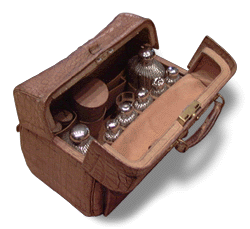
Alfred Nobel’s traveling bag.
He had taken the decisive steps that led to honor and fame. Let us pause a moment at the year 1873, when Alfred Nobel was 40 years old. All these events had taken place during the preceding 10 years. At age 30, Alfred had received his first patent. Now, by age 40, he had already made his greatest discoveries, he had built up a worldwide industrial empire, he had become wealthy, and he had bought a large house in the center of Paris. The foundation was in place. He later made new discoveries – primarily blasting gelatin and ballistite – and his industrial enterprises, as well as his fortune, grew. His distinguishing quality was his versatility. He was an inventor, an industrialist and an administrator. He had to safeguard his patent rights, develop products, establish new companies, and conduct business in five languages with the rest of the world – without the help of a secretary and before the telephone and fax made people’s lives easier. He frequently traveled by train or boat, since this was before the advent of the airplane. His factories exploded, he had to withstand negative publicity campaigns, and he unmasked deceitful business partners. He had to deal with all of this himself. In addition, he seldom felt well – he viewed himself as sickly and frail, often complaining of migraines, rheumatism and an unsettled stomach. His life was hectic and stressful. In letters he wrote from Paris, he complained of being constantly hounded by people, which he described in his own words as “pure torture.” People are crazy, he wrote – they rushed in and out of his office, everyone wanted to see him, and his presence was required everywhere. But despite everything, he managed to cope. In the role of the entrepreneur, he was unbeatable.
* * *
I would like to touch upon another level of Alfred Nobel’s personality, that of the humanist and philosopher. We know that he had literary interests and ambitions. He was an avid reader of fiction and wrote his own dramatic works and poems. In addition, he was attracted to philosophical issues. He read certain philosophical works with such interest that he underlined important passages. Among the papers that he left behind is a black notebook on philosophy that his biographers have not taken an interest in. Although not constituting profound original thoughts, these penciled notes reflect his serious interest in philosophical questions. Nobel went through philosophy from antiquity to modern times, pointing out what he perceived to be vital issues. He made his own comments, which in a morose way showed his detachment from the subject. He commented on Plato, Aristotle and Democritus, but also on Newton and Voltaire as well as contemporary biologists such as Darwin and Haeckel. Nobel noted, for example, that it was unclear what caused people to form a conception of a God: “Aristotle attributes it to fear, Voltaire to the desire of the more clever to deceive the stupid.” He spoke with respect of the philosophical doubts of Descartes and Spinoza, adding that doubt must surely be the starting point for all philosophical thinking. Theories of knowledge were of special interest to Nobel. Consequently, he returned several times to Locke’s thesis that all knowledge arises from sensory impressions, declaring that the “brain is a very unreliable recorder of impressions.”
This led him to reflect further on the methodology of science and to develop a line of reasoning that, aside from being inspired by Locke’s thesis, also seemed to have been influenced by Alexander von Humboldt’s theory of knowledge. Nobel wrote that all science is built on observations of similarities and differences. He continued:
“A chemical analysis is of course nothing other than this, and even mathematics has no other foundation. History is a picture of past similarities and differences; geography shows the differences in the earth’s surface; geology, similarities and differences in the earth’s formation, from which we deduce the course of its transformations. Astronomy is the study of similarities and differences between celestial bodies; physics, a study of similarities and differences that arise from the attraction and motive functions of matter. The only exception to this rule is religious doctrine, but even this rests on the similar gullibility of most people. Even metaphysics – if it is not too insane – must find support for its hypotheses in some kind of analogy. One can state, without exaggeration, that the observation of and the search for similarities and differences are the basis of all human knowledge.”
Nobel could have completed this train of thought with Humboldt’s words that “from observation one goes on to experimentation….based on analogies and inductions of empirical laws.” Nobel did not espouse any grand theory of knowledge, but rather an empirical method. Alfred Nobel himself seemed to think that he had accomplished quite a lot by applying this method in his work.
Alfred Nobel also viewed himself with detachment, or shall we say, philosophical skepticism. He often described himself as a loner, hermit, melancholic or misanthrope. He once wrote: “I am a misanthrope and yet utterly benevolent, have more than one screw loose yet am a super-idealist who digests philosophy more efficiently than food.” Even from this description, it is clear that this misanthrope was also a philanthropist, or what Nobel called a super-idealist. It was the idealist in him that drove Nobel to bequeath his fortune to those who had benefited humanity through science, literature and efforts to promote peace.
* * *
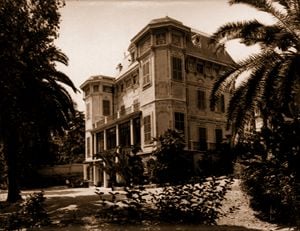
Villa Nobel in San Remo, Italy.
For Alfred Nobel, the idea of giving away his fortune was no passing fancy. He had thought about it for a long time and had even re-written his will on various occasions in order to weigh different wordings against each other. Efforts to promote peace were close to his heart, largely inspired by his contacts with Bertha von Suttner (herself a Nobel Peace Prize laureate in 1905). He derived intellectual pleasure from literature, while science built the foundation for his own activities as a technological researcher and inventor. On November 27, 1895, Nobel signed his final will and testament at the Swedish-Norwegian Club in Paris.
Alfred Nobel had many different homes during the final decades of his life. In 1891, he had left Paris to live in San Remo, Italy, after controversies with the French authorities. Four years later, he purchased the Bofors ironworks and armaments factory in Sweden and established his Swedish home at nearby Björkborn Manor. He equipped all his residences with laboratories where he could continue his experiments. He was apparently homesick for Sweden but complained of the Swedish winter weather. His health began to falter. He visited doctors and health resorts more frequently, but never had time to heed their most important advice – “to rest and nurse my health,” as he put it himself. On December 10, 1896, Alfred Nobel passed away at his home in San Remo.
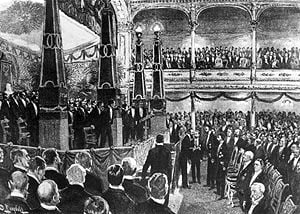
The first Nobel Prize Award Ceremony was held in 1901 at the Royal Academy of Music, Stockholm.
Nobel’s will was hardly longer than one ordinary page. After listing bequests to relatives and other people close to him, Nobel declared that his entire remaining estate should be used to endow “prizes to those who, during the preceding year, shall have conferred the greatest benefit to mankind.” His will attracted attention throughout the world. It was unusual at that time to donate large sums of money for scientific and charitable purposes. Many people also criticized the international character of the prizes, saying they should be restricted to Swedes. This would not have suited the cosmopolitan Alfred Nobel. Some of his relatives contested the will. Complicated legal and administrative matters also had to be sorted out. All this took time, but eventually it was all settled.
In 1901, the first Nobel Prizes were awarded. The donor himself could hardly have dreamed of the impact that his benevolence would have in the future.
* * *
The commemorative medal that has been struck for this occasion — designed by the artist Rune Karlzon — is intended to remind us of some of Alfred Nobel’s various activities. The back of the medal shows a tunnel blasted by dynamite and a detonator or blasting cap. On the front of the medal is a portrait of Nobel, with the Latin inscription Creavit et promovit, which can be translated “He created and promoted.” This sums up, in the briefest possible way, the remarkable accomplishments of Alfred Nobel.
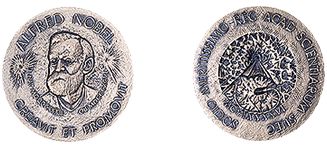
The Royal Swedish Academy of Sciences’ commemorative medal in honor of Alfred Nobel and his work.
*Tore Frängsmyr holds a personal professorship in the History of Science at the University of Uppsala, Sweden. He is also director of the Center for History of Science at the Royal Swedish Academy of Sciences and editor of Les Prix Nobel, the yearbook of the Nobel Foundation, published since 1901. His books include Linnaeus, the Man and his Work (1983, new edition 1994) and Science in Sweden: The Royal Swedish Academy of Sciences, 1739-1989 (1989).
For more information about the Enlightenment, watch the virtual exhibition “The Enlightenment” at La Bibliothèque nationale de France.
First published 8 December 1998